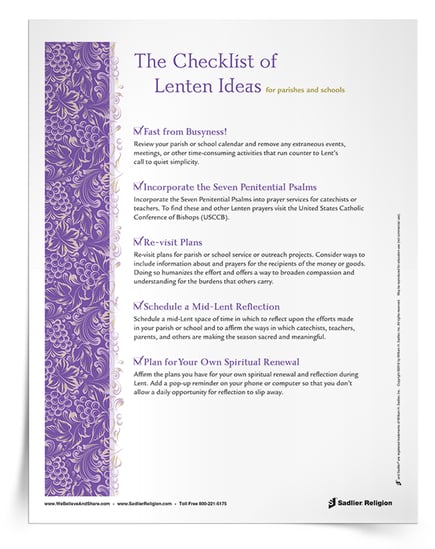March 7, 2022 WBAS Seasonal Lent, REL Seasons - Lent, REL PD - Leaders
Ash Wednesday for some is like a religious New Year’s. It’s the kick-off for Lenten resolutions that begin with great fervor and dim as the six weeks of the season drag on. I recall my own experience of giving something up for Lent. What seemed pretty courageous in the beginning – sacrificing chocolate, for example – turned into drudgery and then resentment by Holy Week. Binging on Easter candy took the meaning of the festival season that follows Lent a little too literally.

Lent is often referred to as a journey - one that begins in the desert and ends in a garden. Each Sunday of Lent draws us closer to the great high point of the liturgical year – the celebration of the Triduum and immersion into the Passion, death, and Resurrection of Jesus. When viewed in this manner, we focus less on giving up and more on giving ourselves over. Framed within three traditional practices of prayer, fasting, and almsgiving, we are offered a precious opportunity to encounter Christ as we make our way towards Easter.
When Lent comes around I feel inspired by the opportunity to deepen my prayer, empty myself of pettiness, and expand my capacity for generosity. It long ago stopped being a season of resolutions and has since become one of reflection, reverence, and re-formation. At its end I hope that I have learned to mirror Christ a little more this time around.
So how can Catholic catechetical leaders and school leaders personally encounter Christ this Lenten season? And how can Catholic catechetical leaders and school leaders encourage children and adults in their religious education programs to encounter Christ through the traditional Lenten practices?

#1 Lenten Prayer
Prayer, as with all liturgical seasons, is an integral part of Lent. The prayer practices specific to Lent - such as the Stations of the Cross, the Seven Penitential Psalms, or the Songs of the Suffering Servant - offer ways to reflect upon and contemplate the great mystery of Jesus’ suffering and death. The cross remains central to these reflections as a symbol of his Passion. The great mystic, Clare of Assisi, described the “mirror of the cross” as one in which we might see our human capacity for violence as well as our capacity to love. Encounters with Christ in prayer invite us to reflect his love by simply giving ourselves over to it.
Parish/School Application: Help children and families in your religious education program encounter Christ in prayer as they make their way through Lent. Download a Stations of the Cross Prayer and use the handout to invite people to follow in the footsteps of Jesus.

#2 Lenten Fasting
The Lenten practice of fasting and abstinence calls upon us to relinquish certain habits or desires in order to embrace others. Doing so freely rather than from obligation makes the practice all the more meaningful. For the early Christians going without food, for example, enabled a neighbor to eat. In this spirit, we give ourselves over to the needs of others. Fasting also entails kenosis – an emptying out of ourselves in order to make room for Christ. Thus, by fasting from hurtful attitudes, selfish behaviors, ego-driven desires, and other soul-killing patterns, we open ourselves to greater compassion, understanding, mercy, and kindness.
Parish/School Application: Help children and adults in your religious education program encounter Christ through fasting with a Prayer for a Lenten Spirit Prayer Card.

#3 Lenten Almsgiving
Giving generously to others is a form of self-sharing that leads to radical transformation. In offering monetary help to those in need, we ease the burdens others carry. By sharing our time with those who are lonely or in need of a listening ear, we provide comfort and compassion. Through works of social justice, we contribute to the well-being of entire communities and the realization of God’s Kingdom on earth. By giving ourselves over to the suffering of others we come to see in a very real way what Jesus meant when he said, “What you do for others, you do for me” (Paraphrase of Matthew 25:40). Such encounters enable us to face our own suffering with greater strength and trust in the ever-present mercy of Christ.
Parish/School Application: Use the Prayer for a Generous Heart to initiate a discussion with children and adults in your religious education program about the almsgiving they have practiced so far this Lent.
FOR REFLECTION
-
What hope do you have for encountering Christ during the season of Lent?
-
How might you give yourself over to the three traditional Lenten practices in order to grow more prayerful, open-hearted, and generous?
MAKING CONNECTIONS
-
PARISH CATECHETICAL LEADERS – Even though your plans for Lent are well in place, consider how you might tweak them towards encountering Christ through the three traditional practices. Look for ways to incorporate one of the three Lenten practices into gatherings with catechists or families.
-
CATHOLIC SCHOOL LEADERS – Review the plans your school has made for Lent. How does each one draw students, faculty, and families towards an encounter with Christ?
RESOURCES FOR CATECHETICAL AND SCHOOL LEADERS
-
Share Lenten Practices Reflection Cards to help students, faculty, and families keep their momentum strong throughout the six weeks of the Lenten season.
-
Download the What if I'm Asked About Lent? Faith Fact with an explanation of Lent by a Master Catechist to share with junior high school students.
-
Check out the Gather In My Name Lenten Event to see if any of the resources would enhance the Lenten plans already in place in your school or parish.
-
Download the Encountering Christ in Lent Support Article.
-
Download my Checklist of Lenten Ideas and use them to tweak your plans for Lent in your parish or school.




